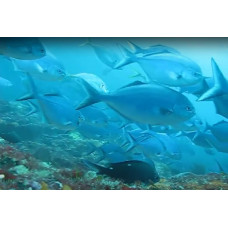Latin name
Scorpis violacea
Other names
Violet sweep, blue sweep, hardbelly.
Identification
They have a laterally compressed and relatively deep body with a conspicuously bifurcated tail. They have prominent jaws with several rows of small, closely spaced teeth used to catch larger zooplankton.
Features of fish fins
The dorsal fin has 9 spines and 27 soft rays, and the anal fin has 2 spines and 25 soft rays.
Fish colouring
Adults are dark blue on the back and pale on the belly, changing to dark green with speckles at night. Juveniles are gray with a yellow anal fin.
Distribution
Inhabit the southwestern Pacific Ocean around North Island, New Zealand, Kermadec Islands, have been found in Australia.
Habitat
A marine benthopelagic species that inhabits coastal waters, especially rocky areas.
Size
Can grow up to 45 centimeters in length. These fish can live up to 15 years.
Behavior
Social fish. Each fish has a favorite sleeping spot among the rocks, and at night they change color from blue to mottled green. Sometimes they sleep in groups on sheltered sandy areas. They have tactile senses and rub against the pebbles when not feeding.
Food and feeding habits
Feed on zooplankton, in the absence of zooplankton eat algae. When feeding in schools chasing shrimp near the surface, the water may foam.
Reproduction
They spawn from September to November and the fry hatch from October to December; the eggs are 0.8 mm in diameter and contain fat droplets.
Fishing
Are commercially important and also a popular commercial fish, popular with recreational fishermen, especially for spearfishing.
Relationship with a person
A species harmless to humans. Edible fish.
| Classification | |
| Phylum | Chordata |
| Class | Actinopterygii |
| Squad | Perciformes |
| Family | Kyphosidae |
| Genus | Scorpis |
| Species | S. violacea |
| Features | |
| Conservation status | Not Evaluated |
| Habitat | Pelagic |
| Life span, years | 15 |
| Maximum body weight, kg | No information |
| Maximum length, cm | 45 |
| Sailing speed, m/s | No information |
| Threat to people | Edible |
| Way of eating | Planktonophage |
Blue maomao
Tags: blue maomao

